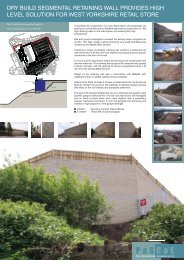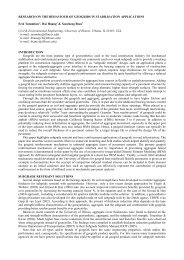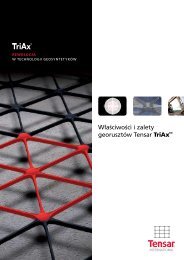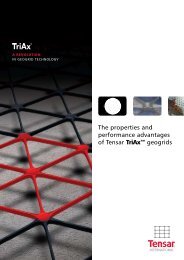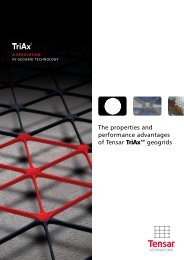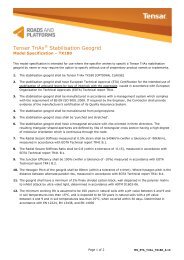3_JP Giroud_edited - Tensar International Ltd.
3_JP Giroud_edited - Tensar International Ltd.
3_JP Giroud_edited - Tensar International Ltd.
Create successful ePaper yourself
Turn your PDF publications into a flip-book with our unique Google optimized e-Paper software.
Survivability of geogrids<br />
Resistance to construction damage is outside the scope of this paper, but it is important to mention it. Like any<br />
geosynthetic used in any application, a geogrid must be sufficiently robust to withstand the rigors of transportation,<br />
handling, installation, placement of materials in contact, and other construction activities. Also, the geogrid must be<br />
capable of maintaining the integrity of its structure and properties throughout its service life. The geogrid material<br />
must also not be degradable in any way in a soil environment.<br />
REVIEW OF THE STATE OF PRACTICE<br />
Scope of the review<br />
The review of the state of practice presented herein is based on both facts and beliefs. While it is essential to know<br />
facts (e.g. percentages of uses per category), it is also important to know how geogrids are perceived by users.<br />
Types of applications<br />
As mentioned in preceding sections, the two main types of applications where an unpaved aggregate layer is<br />
subjected to traffic are unpaved roads and unpaved areas. However, when discussing the state of practice, it is<br />
important to distinguish between, on one hand, unpaved roads that are only used as unpaved roads and, on the other<br />
hand, unpaved roads that are, in fact, the aggregate bases of paved roads under construction and are used as unpaved<br />
roads only during construction of the roads.<br />
Uses of geosynthetics in unpaved roads and unpaved areas<br />
Geotextiles were first used in subgrade stabilisation thanks to pioneering work in the late 1960s by McGown in the<br />
UK and Leflaive in France. During the 1970s, geotextiles became extensively used in subgrade stabilisation<br />
applications (unpaved roads and unpaved areas), first in Europe, then worldwide. Geogrids, developed by Mercer in<br />
the 1970s, appeared in subgrade stabilisation applications in the early 1980s. Since then, they have been extensively<br />
used worldwide in subgrade stabilisation applications. Geocells (geosynthetic honeycomb structures) have been used<br />
to confine aggregate since the 1970s in some military applications; since the 1990s, they have been used in a relatively<br />
small number of civil engineering unpaved roads and unpaved areas.<br />
From limited sources, it is estimated that, in the first decade of the 21 st century, geotextiles are still used more than<br />
geogrids in subgrade stabilisation applications. In comparison, the use of geocells in these applications is very small.<br />
From the same sources, it is estimated that, in the first decade of the 21 st century, the use of geosynthetics in<br />
subgrade stabilisation applications is distributed as follows:<br />
• approximately 25% in real unpaved roads (i.e. unpaved roads that remain unpaved);<br />
• approximately 50% under aggregate layers that are used to carry some traffic while unpaved, but will<br />
eventually become the aggregate bases of paved roads; and<br />
• approximately 25% in unpaved areas.<br />
From the same sources, it appears that, in real unpaved roads, geotextiles are used more than geogrids because<br />
separation is the main consideration in many cases. In these cases, there is generally no design (i.e. no use of a design<br />
method). When no design is involved, the aggregate layer thickness and the geotextile are selected on the basis of<br />
preceding projects using the same geotextile. More generally, it seems that geotextiles are used more than geogrids in<br />
cases where there is no design, whereas geogrids are used more than geotextiles in cases where there is a design.<br />
From the same sources, it appears that, in unpaved roads that are the first phase of construction of paved roads,<br />
geotextiles are used if the main concern is separation, whereas geogrids are used more than geotextiles when<br />
reinforcement is required, in particular when it is considered important to keep deformations of the aggregate layer as<br />
small as possible, which is a legitimate goal since the aggregate layer that is used as a temporary access road should<br />
retain its integrity (thickness, mechanical properties) prior to being incorporated in the paved road structure, in order<br />
to ensure long-term performance.<br />
Finally, from the same sources, it can be said that, in the case of unpaved roads that are the first phase of<br />
construction of paved roads, the market is more or less equally split between geotextiles and geogrids.<br />
Typical considerations involved in comparing geotextiles and geogrids<br />
The main considerations involved in comparing geotextiles and geogrids for stabilisation structures include: the<br />
cost of the geosynthetic, the cost of aggregate, the benefit from improved performance, the separation function,<br />
experience of the decision-maker, and the maximum allowable deformation.<br />
Geosynthetic cost<br />
The cost of the geosynthetic is an important factor in the selection by the user of a geotextile or a geogrid. It varies<br />
significantly from one location to another. In the United States, the cost per square yard (a unit used in the United<br />
States, but unknown in other countries, and equal to approximately 0.8 m 2 ) is approximately $2.4 to 4.8 for installed<br />
geogrids and $1.2 to 2.4 for installed stabilisation geotextiles. As a result of the significant difference in cost,<br />
geotextiles are often preferred to geogrids. Furthermore, the cost of separation geotextiles is very low ($0.5 to 1 per



